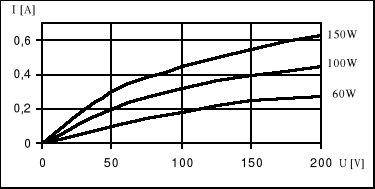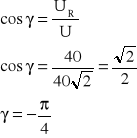Zad. 1.110
Napięcie na rezystorze R5 jest równe 120 V. Obliczyć wartości prądów płynących we wszystkich gałęziach oraz doprowadzonego napięcia zasilającego jeżeli : R1 = R4 = 2Ω,
R2 = R3 = R6 = 4Ω ,
R1
I1
R2 R3
I23
U
R4
R5 I4
I5
R6
I6
![]()
U4 = I4 + R4 = 40 ⋅ 2 = 80V
![]()
Uz = I7 ⋅ Rz = 40 ⋅ 7,4 = 296 V
I7 = I5 + I6 = 40A Uz - U2 - U4 - U5 = 0
I4 = I7 = 40A U2 = Uz - U4 - U5
U2 = 296 - 80 -120 = 96 V
![]()
I1 = I7 - I2 = 40 -24 = 16A
Odp. : Wartości poszczególnych prądów płynących w obwodzie wynoszą odpowiednio : 16A, 24A , 40A, 30A, 10A , a napięcie zasilające 296V.
Zad. 1.111
Obliczyć wartości prądu całkowitego i napięcia doprowadzonego do obwodu, jeżeli spadek napięcia wynosi U6 = 36V, a rezystancje : R1 = 1Ω , R2 = 5Ω , R3 = 12Ω , R4 = 12Ω ,
R5 = 21Ω , R6 = 4Ω.
R1 R2 R3
R4
U
R5 R6
![]()
Iz = I6 + I3 = 12A
U6 - U3 = 0 Uz= Iz ⋅ Rz =12 ⋅ 4 = 48V
U6 = U3 = 36A U = UZ + U6 = 48 + 36 = 84V
![]()
U5 = Uz = 84V
R12 = 1 + 5 = 6Ω ![]()
![]()
IC = I5 + 12 = 4 + 12 = 16A
Odp. : Wartość prądu całkowitego wynosi 16A a wartość napięcia doprowadzonego do obwodu wynosi 84V.
Zad. 1.114
Wyznaczyć wartości prądu w gałęziach obwodu jeżeli : U = 120V ; R1 = R6 = 45Ω ,
R2 = 220Ω , R3 = 76Ω , R4 = 240Ω , R5 = 360Ω .
R1 R2
R3
R4
U
R5
R6

![]()
U16 = I16 ⋅ R1 = 27V
U2 = U - U1 - U6 = 120 - 27 - 27 = 66V
![]()
I3 = I1 - I2 = 0,3A

![]()
![]()
Odp. : Wartość prądów w gałęziach wynoszą: 0,6A ; 0,6A ; 0,3A ; 0,3A ; 0,18A ; 0,12A.
Zad. 1.120
Do dzielnika napięcia składającego się z rezystorów R1 i R2 doprowadzono napięcie
U = 200V. Obliczyć wartości napięcia UZ na wyjściu dzielnika przy otwartym i zamkniętym wyłączniku W. Wartości rezystancji : R1 = 100 Ω , R2 = R3 = 300 Ω
R1
U W
R2 U2 R3
Przy wyłączniku otwartym: Przy wyłączniku zamkniętym:
UZ = U - R1⋅ I UZ = U - R1⋅ I
![]()

UZ = 200 - 100⋅0,5 = 150V UZ = 200 - 100⋅0,8 = 120V
Odp. : Wartość napięcia przy otwartym wyłączniku wynosi 150V a przy zamkniętym 120V
Zad. 1.215
Żarówkę o mocy P = 100W, której charakterystykę I = f (U) przedstawia rys.; połączono równolegle z rezystorem liniowym o rezystancji R = 300Ω. Wyznacz wartość prądu całkowitego, gdy napięcie zasilające wynosi U= 200V.

Z wykresu dla żarówki 100W przy 220V odczytujemy : I = 0,45A
![]()
![]()
![]()
Odp. : Wartość prądu wynosi 1,1A
Zad. 1.176
Grzejnik kuchenki elektrycznej składa się z dwóch spiral o rezystancjach R1 = 40Ω i
R2 = 60Ω. Oblicz wartość mocy kuchenki przy czterech możliwych sposobach połączenia spiral (połączenie szeregowe, włączona tylko druga spirala, włączona tylko pierwsza spirala, połączenie równoległe spiral). Napięcie zasilające wynosi U = 220V.
R1 R2
U
R1
W1
W2 R2
U
Przy W1 zwartym i W2 rozwartym
![]()
Przy W1 zwartym i W2 zwartym

Zad. 7.11
Prąd : napięcia mają następujące przebiegi U = 310sinωt ; ![]()
. Oblicz wartości chwilowe napięcia i prądu, jeżeli czas t = 0,005 s , a częstotliwość f = 50 Hz.
t = 0,005 s U = 310sinωt= 310sin2π⋅50⋅0,005 = 310V
f = 50 Hz ω = 2π⋅f
![]()
Odp. : Wartość chwilowa napięcia wynosi 310V a prądu równe 1,41
Zad. 7.55
Cewkę o rezystancji R = 80Ω i indukcyjności L = 0,255 H przyłączono do źródła o napięciu U = 24V i częstotliwości f = 50Hz. Obliczyć wartości : prądu I płynącego w obwodzie ; napięć UR , UL oraz przesunięcia fazowego γ między prądem i napięciem; sporządź wykres wektorowy prądu i napięć.
R = 80Ω
L = 0,255 H
U = 24V
xL= 2πf L= 80Ω
z = R + jxL = 80 + 80j
![]()
![]()
UC
UR = I⋅R = 0,212A ⋅ 80Ω = 17V
UL = 2⋅xL = 0,212 ⋅ 80 = 17V
tgγ

UR I
Odp. : Wartość prądu płynącego w obwodzie 0,212A, zaś napięcia UR = 17V i UL = 17V ; tgγ = 45°
Zad. 7.67
Do dwóch cewek o parametrach : R1 = 5Ω , L1 = oraz R2 = 8Ω, L2 = 3,19mH , połączonych szeregowo, doprowadzono napięcie sinusoidalne o wartości skutecznej U = 3,7V i częstotli-wości f = 500Hz . Obl. Wartość impedancji z obwodu, spadków napięcia UL1, UL2 na obu cewkach, cosγ każdej cewki i całego obwodu oraz sporządź wyk. wektorowy prądu i napięć.
L1 = 1mH = 0,001 H R1 L1 R2 L2
L2 = 3,19mH = 0,00319 H U
xL1 = 2πf L1 = 3,14Ω xL2 = 2πf L2 = 10,0166Ω ≅ 10Ω
z = 5 + 3,14j + 8 + 10j z = 13 + 13, 14j
![]()
![]()
Obliczam spadek napięcia na cewce 1: Obliczam spadek napięcia na cewce 2:
z = 5 + 3,14j z = 10 + 8j
![]()
![]()
UL1= I ⋅ z1 = 0,2 ⋅ 5,9 = 1,18 V UL2= I ⋅ z2 =12,8 ⋅ 0,2 = 2,56 V
Dla układu 1:
UL UL'
UR1 = I ⋅ R1 = 5 ⋅ 0,2 = 1V
![]()
spadek na L1
γ1 = 32° γ1
I
UR1
Dla układu 2:
UL
UR2 = I ⋅ R2 = 0,2 ⋅ 8 = 1,6V
![]()
spadek na L2
γ1 = 51,3° γ2
I
UR2
Dla całego układu :
UL + UL U
UR1 + UR2 = 2,6V
Suma spadków
![]()
na L1 i L2
γ
γ = 45,3°
UR1 + UR2 I
Odp. : Wartość impedancji układu wynosi 18,5Ω, wartości spadków 1,18V oraz 2,56V , cosinusy spadków wynoszą : 0,848 ; 0,625 ; 0,703
Zad. 7.134
Obliczyć wartości prądów płynących w gałęziach obwodu. Dane są rezystancja :
R1 = R2 = R3 = 4Ω ; reaktancja x1 = x2 = 12Ω, x3 = 32Ω, napięcie zasilające U=50V.
R1 L1 L3
R2 C2
Z1 Z3
Z2
U
R1 = R2 = R3 = 4Ω
x1 = x2 = 12Ω
x3 = 32Ω
U = 50V
z1 = 4 + 12j ; z2 = 4 - 12j ; z3 = 4 + 32j
![]()
zw = z12 + z3 = 24 +32j
![]()
U12 = I ⋅ z12
![]()


![]()

7.91
W równoległym obwodzie RC całkowity prąd wynosi I = 2,5A, prąd przepływającego przez kondensator IC = 1,2A . Obliczyć wartość prądu płynącego przez rezystor oraz narysuj trójkąt prądów.
C
I IC
I = 2,5A
IC = 1,2A IC
IR
R
![]()
I
![]()
Odp. : Wartość prądu płynącego przez rezystor wynosi 2,193A
8.29
Dla układu trzech impedancji ![]()
; ![]()
; ![]()
,
połączonych w gwiazdę, znajdź impedancje równoważnego trójkąta.



7.137
U = 200V
z1 = (30+20j) Ω ; z2 = (-20j) Ω ; z3 = (20j) Ω ; z4 = (10-10j) Ω ; z5 = (10+10j) Ω ;
![]()
z3,45 = z3,4 + z5 = 20 + 20j
![]()
z1,23,4,5 = 50Ω

U1 = I ⋅ z1 = 120 + 80j
U2 = U - U1 = 200 - 120 - 80j = 80 - 80j
U3,4,5 = U2

U3,4 = I3,4,5 ⋅ z3,4 = - 4j ⋅ (10+10j) = - 40j + 40 = (40 - 40j)V

Moc czynna P = U⋅ J ⋅ cosγ
XC =10
R=10
I
U
UR I
γ
UL
U
![]()
Moc bierna

Moc pozorna
![]()
8.9
Obliczyć wartości prądów płynących w gałęziach obwodu, stosując metodę superpozycji.
Dane:
E1 R3
I1 I3
R6 I1 R4
I6 I2 I5
R8 E2
R5
I8 R6 R7
R7
R8
I2
R4
I4
R3
I3
I'5 = 0
![]()
; ![]()
; ![]()
; ![]()
![]()
; ![]()
; ![]()
![]()
; ![]()
; ![]()
![]()
; ![]()
; ![]()
![]()
; ![]()
![]()
![]()
![]()
![]()
![]()
![]()
![]()
![]()
8.11
Obliczyć wartość prądu I2 (metodą Thevenina i Nortona), płynącego w obwodzie:
R1 = 3Ω ; R2 = 12Ω ; R3 = 4Ω ; U = 6V
R1 R2
U R3 I2
![]()
; ![]()
![]()
![]()

; 
9.4
Trzy jednakowe odbiorniki o impedancjach z = (6+8j) Ω, połączone w gwiazdę, są zasilane z symetrycznej sieci trójfazowej o napięciu międzyfazowym U = 380V. Obliczyć wartości prądów odbiorników.
U = UAB = UAC = UBC = 380V
W podanym układzie IA = IB = IC
![]()
![]()
zA = (6+8j) Ω
![]()

11.12
Obliczyć wartości pulsacji rezonansowej obwodu, gdy połączenie cewek jest a) zgodne ;
b) przeciwne. Dane są indukcyjności cewek : L1 = 10mH ; L2 = 40mH , indukcyjność wzajemna M = 15mH ; pojemność C = 60nF.
R1 L1
∼ M C
R2 L2
a) przy połączeniu zgodnym ⇒ L = L1 +L2 + 2M = 10 + 40 + 2⋅ 15 = 80 mH
![]()
b) przy połączeniu przeciwnym ⇒ L = L1 +L2 - 2M = 10 + 40 - 2⋅ 15 = 20 mH
![]()
13.5
Wyznacz wartości początkowe i ustalone prądów i1 , i2 po zamknięciu wyłącznika w obwodu.
Dane: napięcie U = 24V, rezystancje R1 = 48Ω , R2 = 100Ω, indukcyjność L = 5mH, pojemność C = 0,5 nF.
W
i1 i2
U R1 R2
C L
w chwili t = 0 ładowany jest kondensator, przez cewkę prąd nie płynie , a przez rezystor R1 płynie prąd
![]()
a przy t = ∝ kondensator jest naładowany
![]()
8.27
Dwie jednakowe, oddalone od siebie prądnice, o siłach E1 = E2 = 240V i rezystancjach wewnętrznych : RW1 = RW2 = 1Ω ; R2 = 9Ω ; R3 = 19Ω oraz współpracują ze sobą za pośrednictwem linii dwuprzewodowej. Rezystancje przewodów linii: R1 = R4 = 0,5Ω. Oblicz wartość prądu płynącego w gał. metodą Thevenina.
R1
E1 R2 R3 E2
R4
E1 = E2 = 240V ; RW1 = RW2 = 1Ω ; R2 = 9Ω ; R3 = 19Ω ; R1 = R4 = 0,5Ω
R1
RW1 R2 R3 RW2

![]()

8.13
Dane: E1 = 12V ; E2 = 6V ; R1 = 3Ω ; R2 = 6Ω ; R3 = 2Ω ; R4 = 10Ω . Obliczyć P4
E1
I2
I1 R1 R2
I3
E2 R4
R3
Metoda Thevenina
Ut = (I1 = I2) ⋅ R2 + E2
![]()
![]()
![]()
![]()
P4 = I32 ⋅ R4 = 10W
15
P = U ⋅ I = ![]()

Przy W1 rozwartym i W2 zwartym
![]()
![]()
UR = I ⋅ R
UR = 4 ⋅ 10 = 40

E1 = 36V
E2 = 24V
R3 = 10Ω
R4 = 6Ω
R5 = 12Ω
R6 = 12Ω
R7 = 6Ω
R8 = 10Ω
![]()
R456 = 2 + 3 = 5Ω
R13 = 2 + 4 = 6Ω
![]()
R123456 = 2,4 + 5 = 7,4 Ω
U5 = 120 V
R2 = R3 = R6 = 4Ω
R1 = R4 = 2Ω
R5 = 12Ω
Metoda równ. Kirchoffa


![]()
18 = 12 ⋅ I1 - 24 + 6⋅ I1 + 3⋅ I1
42 = 21⋅ I1
I1 = 2A ; ![]()
; I3 = 2-1= 1A
P4 = I32 ⋅ R4 = 10W
Wyszukiwarka